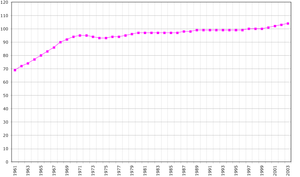Demographics of Tonga
Tongans, a Polynesian group, represent more than 98% of the inhabitants of Tonga. The rest are European (the majority are British), mixed European, and other Pacific Islanders. There also are several hundred Chinese. Almost two-thirds of the population live on its main island, Tongatapu. Although an increasing number of Tongans have moved into the only urban and commercial center, Nukuʻalofa, where European and indigenous cultural and living patterns have blended, village life and kinship ties continue to be important throughout the country. Everyday life is heavily influenced by Polynesian traditions and especially by the Christian faith; for example, all commerce and entertainment activities cease from midnight Saturday until midnight Sunday, and the constitution declares the Sabbath to be sacred, forever. Other important Christian denominations include Methodists (Free Wesleyan) and Roman Catholics.
Fakatonga | |
|---|---|
 | |
| Languages | |
| Tongan and English | |
| Religion | |
| Christianity, Polytheism, Polynesian narrative | |
| Related ethnic groups | |
| Other Polynesians |

Primary education between ages 6 and 14 is compulsory and free in state schools. Mission schools provide about 83% of the primary and 90% of the secondary level education. Higher education includes teacher training, nursing and medical training, a small private university, a women's business college, and a number of private agricultural schools. Most higher education is pursued overseas.
Based on 2006 estimates, the religious breakdown of the population was Protestant 64.9% (includes Free Wesleyan Church 37.3%, Free Church of Tonga 11.4%, Church of Tonga 7.2%, Tokaikolo Christian Church 2.6%, Assembly of God 2.3%, Seventh Day Adventist 2.2%, Constitutional Church of Tonga 0.9%, Anglican 0.8% and Full Gospel Church 0.2%), Latter-day Saints 16.8%, Roman Catholic 15.6%, other 1.1%, none 0.03%, unspecified 1.7%.[1]
As the 1960s ended the population growth rate fell rapidly in the country.
Population history
In the 1930s Tonga had a population of about 32,000. Starting in the 1970s large scale migration began to Australia and New Zealand. By the 1970s the emigration rate from Tonga to Australia, New Zealand, United Kingdom, Canada, France and the United States was over 2% annually.[2]